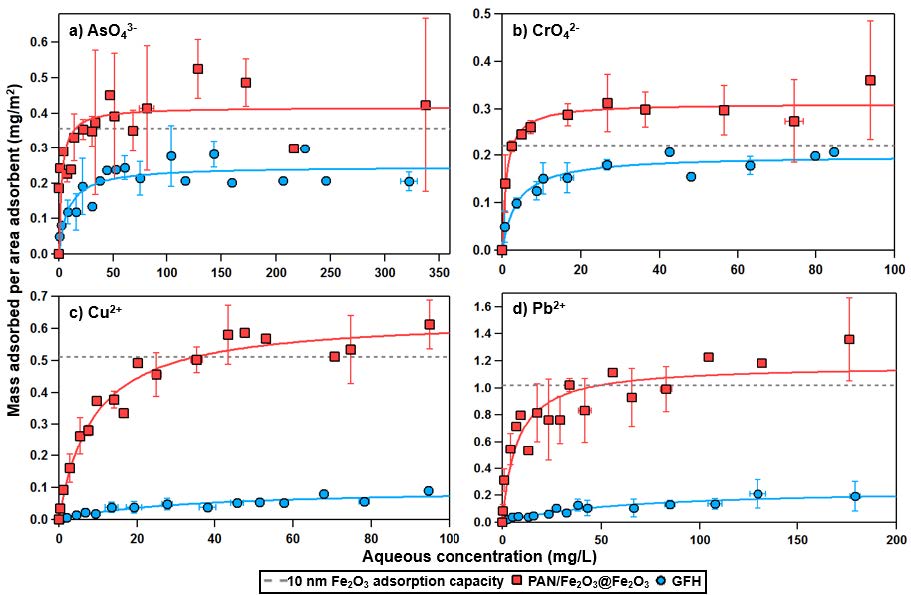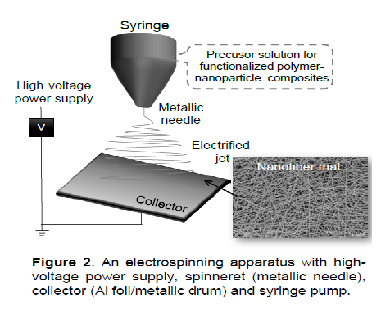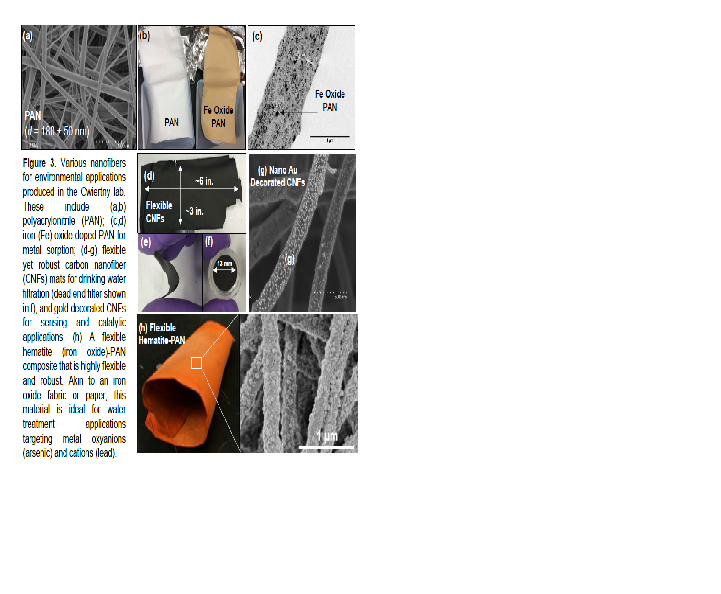Grantee Research Project Results
Final Report: Research and Demonstration of Electrospun Nanofiber Filters: Multifunctional, Chemically Active Filtration Technologies for Small-Scale Water Treatment Systems
EPA Grant Number: R835177Title: Research and Demonstration of Electrospun Nanofiber Filters: Multifunctional, Chemically Active Filtration Technologies for Small-Scale Water Treatment Systems
Investigators: Cwiertny, David M. , Parkin, Gene F , Myung, Nosang V.
Institution: University of Iowa , University of California - Riverside
EPA Project Officer: Packard, Benjamin H
Project Period: December 1, 2011 through November 30, 2016
Project Amount: $499,466
RFA: Research and Demonstration of Innovative Drinking Water Treatment Technologies in Small Systems (2011) RFA Text | Recipients Lists
Research Category: Drinking Water , Water
Objective:
This research and demonstration plan aimed to fabricate multi-component nanofiber mats via a novel synthesis approach, electrospinning, and optimize their performance as chemically active filtration technologies for water treatment. The vision for this versatile, point-of-use (POU) water treatment technology is shown in Figure 1, in which nanotechnology is harnessed to shrink the size and scale of water treatment, while specific layers of the filter can be tailored to address a range of drinking water quality problems (e.g., disinfection byproducts, persistent organic pollutants, emerging micropollutants, metals, oxyanions and pathogens).
Summary/Accomplishments (Outputs/Outcomes):
This project successfully developed chemically functional nanomaterials for applications that promote environmental sustainability and more resilient water supplies. For nanomaterial fabrication, we rely upon the process of electrospinning (Figure 2), which yields high surface area nanofiber networks deployable as porous non-woven mats (Figure 3). It also allows facile control of nanofiber diameter (from ~20 nm to ~1 μm) using tunable synthesis variables (e.g., applied voltage, precursor solution viscosity, humidity) and the ability to manipulate nanofiber composition by integrating desired components directly into the spinning precursor solution. More practically, electrospinning is emerging as a high-yield, highly scalable process, producing robust nanofiber networks ideal for environmental application, often times using ambient conditions that minimize the energy intensity of nanomaterial synthesis.


Conclusions:
Journal Articles on this Report : 9 Displayed | Download in RIS Format
| Other project views: | All 21 publications | 9 publications in selected types | All 9 journal articles |
|---|
| Type | Citation | ||
|---|---|---|---|
|
|
Egodawatte S, Greenstein KE, Vance I, Rivera E, Myung NV, Parkin GF, Cwiertny DM, Larsen SC. Electrospun hematite nanofiber/mesoporous silica core/shell nanomaterials as an efficient adsorbent for heavy metals. RSC Advances 2016;6(93):90516-90525. |
R835177 (Final) |
Exit Exit |
|
|
Nalbandian MJ, Zhang M, Sanchez J, Choa Y-H, Cwiertny DM, Myung NV. Synthesis and optimization of BiVO4 and co-catalyzed BiVO4 nanofibers for visible light-activated photocatalytic degradation of aquatic micropollutants. Journal of Molecular Catalysis A: Chemical 2015;404-405:18-26. |
R835177 (2015) R835177 (Final) |
Exit Exit |
|
|
Nalbandian MJ, Zhang M, Sanchez J, Kim S, Choa Y-H, Cwiertny DM, Myung NV. Synthesis and optimization of Ag–TiO2 composite nanofibers for photocatalytic treatment of impaired water sources. Journal of Hazardous Materials 2015;299:141-148. |
R835177 (2012) R835177 (Final) |
Exit Exit Exit |
|
|
Nalbandian MJ, Greenstein KE, Shuai D, Zhang M, Choa Y-H, Parkin GF, Myung NV, Cwiertny DM. Tailored synthesis of photoactive TiO2 nanofibers and Au/TiO2 nanofiber composites:structure and reactivity optimization for water treatment applications. Environmental Science & Technology 2015;49(3):1654-1663. |
R835177 (2015) R835177 (Final) |
Exit Exit Exit |
|
|
Nalbandian MJ, Zhang M, Sanchez J, Kim S, Choa Y-H, Nam J, Cwiertny DM, Myung NV. Synthesis and optimization of Fe2O3 nanofibers for chromate adsorption from contaminated water sources. Chemosphere 2016;144:975-981. |
R835177 (2015) R835177 (Final) |
Exit Exit Exit |
|
|
Nalbandian MJ, Zhang M, Sanchez J, Nam J, Cwiertny DM, Myung NV. Mesoporous θ-alumina/hematite (θ-Al2O3/Fe2O3) composite nanofibers for heavy metal removal. Science of Advanced Materials 2017;9(1):22-29. |
R835177 (Final) |
Exit Exit |
|
|
Peter KT, Vargo JD, Rupasinghe TP, De Jesus A, Tivanksi AV, Sander EA, Myung NV, Cwiertny DM. Synthesis, optimization, and performance demonstration of electrospun carbon nanofiber-carbon nanotube composite sorbents for point-of-use water treatment. ACS Applied Materials & Interfaces 2016;8(18):11431-11440. |
R835177 (Final) |
Exit Exit Exit |
|
|
Peter KT, Johns AJ, Myung NV, Cwiertny DM. Functionalized polymer-iron oxide hybrid nanofibers: electrospun filtration devices for metal oxyanion removal. Water Research 2017;117:207-217. |
R835177 (Final) |
Exit Exit Exit |
|
|
Peter KT, Myungb NV, Cwiertny DM. Surfactant-assisted fabrication of porous polymeric nanofibers with surface-enriched iron oxide nanoparticles:composite filtration materials for removal of metal cations. Environmental Science: Nano 2018;5:669-681. |
R835177 (Final) |
Exit |
Supplemental Keywords:
Decentralized treatment, point of use treatment, nanotechnology, water reuse, catalysis, water treatment, wastewater treatment, water treatment system, nanofiber filtersProgress and Final Reports:
Original AbstractThe perspectives, information and conclusions conveyed in research project abstracts, progress reports, final reports, journal abstracts and journal publications convey the viewpoints of the principal investigator and may not represent the views and policies of ORD and EPA. Conclusions drawn by the principal investigators have not been reviewed by the Agency.
Project Research Results
- 2015 Progress Report
- 2014 Progress Report
- 2013 Progress Report
- 2012 Progress Report
- Original Abstract
9 journal articles for this project



